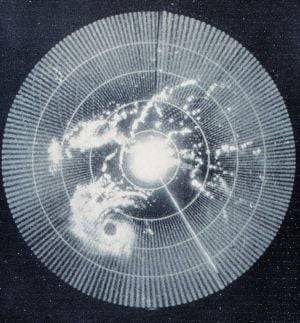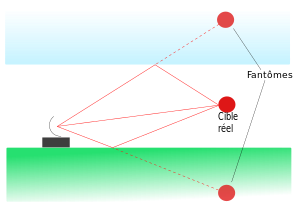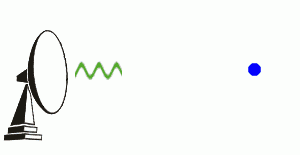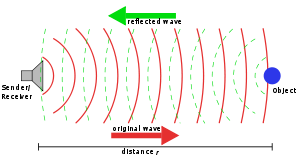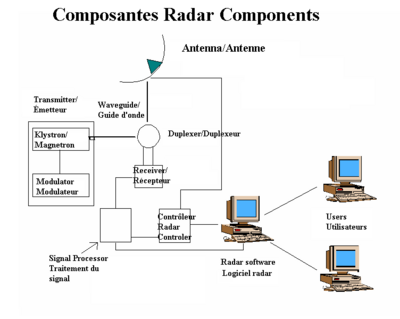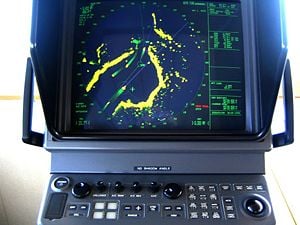Radar
RADAR is a detection system that uses radio waves to determine and map the location, direction, and/or speed of both moving and fixed objects such as aircraft, ships, motor vehicles, weather formations and terrain. A transmitter emits radio waves, which are reflected by the target and detected by a receiver, typically in the same location as the transmitter. Although the radio signal returned is usually very weak, radio signals can easily be amplified, so radar can detect objects at ranges where other emissions, such as sound or visible light, would be too weak to detect. Radar is used in many contexts, including meteorological detection of precipitation, air traffic control, police detection of speeding traffic, and by the military.
The term RADAR was coined in 1941 as an acronym for Radio Detection and Ranging. This acronym of American origin replaced the previously used British abbreviation RDF (Radio Direction Finding). The term has since entered the English language as a standard word, radar, losing the capitalization in the process.
History
Several inventors, scientists, and engineers contributed to the development of radar. The use of radio waves to detect "the presence of distant metallic objects via radio waves" was first implemented in 1904 by Christian Hülsmeyer, who demonstrated the feasibility of detecting the presence of a ship in dense fog, but not its distance.[1] He received a Reichspatent patent Nr. 165546 for his pre-radar device in April and on November 11, 1904, the patent 169154, an amendment of his patent for ranging that is indirectly related to his device. He received a patent (GB13170) in England for his telemobiloscope on September 22, 1904.
Prior to the Second World War, developments by the Americans, the Germans, the French (French Patent n° 788795 in 1934),[2] and the British (British Patent GB593017 by Robert Watson-Watt in 1935), led to the first real radars. Hungarian Zoltán Bay produced a working model by 1936 at the Tungsram laboratory in the same vein.
The war precipitated the research to find better resolution, more portability, more features for that new defensive weapon. Post-war years have seen the use of radar in fields as diverse as air traffic control, weather monitoring, astrometry (branch of astronomy that deals with the positions of stars and celestial bodies), and road speed control.
Principles
Reflection
Electromagnetic waves reflect off of a solid object in air or vacuum, or other significant change in atomic density between the object and what is surrounding it. This is particularly true for electrically conductive materials, such as metal and carbon fiber, making radar particularly well suited to the detection of aircraft and ships. Radar absorbing material, containing resistive and sometimes magnetic substances, is used on military vehicles to reduce radar reflection. This is the radio equivalent of painting something a dark color.
Radar waves scatter in a variety of ways depending on the size (wavelength) of the radio wave and the shape of the target. If the wavelength is much shorter than the target's size, the wave will bounce off in a way similar to the way light is reflected by a mirror. If the wavelength is much longer than the size of the target, the target cannot be clearly distinguished. When the two length scales are comparable, there may be resonances. Early radar used very long wavelengths that were larger than the targets and received a vague signal, whereas some modern systems use shorter wavelengths (a few centimeters or shorter) that can image objects as small as a loaf of bread or smaller.
Short radio waves reflect from curves and corners, in a way similar to glint from a rounded piece of glass. The most reflective targets for short wavelengths have 90° angles between the reflective surface. A structure consisting of three flat surfaces meeting at a single corner, like the corner on a box, will always reflect waves entering its opening directly back at the source. These so-called corner reflectors are commonly used as radar reflectors to make otherwise difficult-to-detect objects easier to detect, and are often found on boats in order to improve their detection in a rescue situation and to reduce collisions. For similar reasons, objects attempting to avoid detection will angle their surfaces in a way to eliminate inside corners and avoid surfaces and edges perpendicular to likely detection directions, which leads to "odd" looking stealth aircraft. Half wavelength long wires or strips of conducting material, such as chaff, are very reflective but do not direct the scattered energy back toward the source. The extent to which an object reflects or scatters radio waves is called its radar cross section.
Polarization
In the transmitted radar signal, the electric field is perpendicular to the direction of propagation, and this direction of the electric field is the Polarization of the wave. Radars use horizontal, vertical, and circular polarization to detect different types of reflections. For example, circular polarization is used to minimize the interference caused by rain. Linear polarization returns usually indicate metal surfaces, and help a search radar ignore rain. Random polarization returns usually indicate a fractal surface, such as rocks or soil, and are used by navigational radars.
Interference
Radar systems must overcome several different sources of unwanted signals in order to focus only on the actual targets of interest. These unwanted signals may originate from internal and external sources, both passive and active. The ability of the radar system to overcome these unwanted signals defines its signal-to-noise ratio (SNR): the higher a system's SNR, the better it is in isolating actual targets from the surrounding noise signals.
Noise
Signal noise is an internal source of random variations in the signal, which is inherently generated to some degree by all electronic components. Noise typically appears as random variations superimposed on the desired echo signal received in the radar receiver. The lower the power of the desired signal, the more difficult it is to discern it from the noise (similar to trying to hear a whisper while standing near a busy road). Therefore, the most important noise sources appear in the receiver and much effort is made to minimize these factors. Noise figure is a measure of the noise produced by a receiver compared to an ideal receiver (which generates no noise), and this needs to be minimized.
Noise is also generated by external sources, most prominently the natural thermal radiation of the background scene surrounding the target of interest. In modern radar systems, due to the high performance of their receivers, the internal noise is typically about equal to or lower than the external scene noise. An exception is if the radar is aimed upwards at clear sky, where the scene is so cold that it generates very little thermal noise.
Clutter
Clutter refers to actual radio frequency (RF) echoes returned from targets that are by definition uninteresting to the radar operators in general. Such targets mostly include natural objects such as ground, sea, precipitation (such as rain, snow or hail), sand storms, animals (especially birds), atmospheric turbulence, and other atmospheric effects (such as ionosphere reflections and meteor trails). Clutter may also be returned from man-made objects such as buildings and, intentionally, by radar countermeasures such as chaff.
Some clutter may also be caused by a long waveguide (a cable or fiber transmitting the signal) between the radar transceiver and the antenna. In a typical plan position indicator (PPI) radar with a rotating antenna, this will usually be seen as a "sun" or "sunburst" in the center of the radar operator’s display as the receiver responds to echoes from dust particles and misguided RF in the waveguide
While some clutter sources may be undesirable for some radar applications (such as storm clouds for air-defense radar), they may be desirable for others (meteorological radar for instance). Clutter is considered a passive interference source, since it only appears in response to radar signals sent by the radar.
There are several methods of detecting and neutralizing clutter. Many of these methods rely on the fact that clutter tends to appear static between radar scans. Therefore, when comparing subsequent scan echoes, desirable targets will appear to move and all stationary echoes can be eliminated. Horizontal polarization can reduce sea clutter, while rain is reduced with circular polarization (note that meteorological radar wish for the opposite effect, therefore using linear polarization to better detect precipitation).
Clutter may also originate from multipath echoes (that reach the receiver from two or more paths) from valid targets due to ground reflection, atmospheric ducting (where the Earth’s atmosphere thins out such that the waves are propagated at a constant altitude, instead of bouncing up and down between the ground and the atmosphere), and ionospheric reflection/refraction. This specific clutter type is especially bothersome, since it appears to move and behave like other normal (point) targets of interest, thereby creating a ghost. In a typical scenario, an aircraft echo is multipath-reflected from the ground below, appearing to the receiver as an identical target below the correct one. The radar may try to unify the targets, reporting the target at an incorrect height, or—worse—eliminating it on the basis of jitter or a physical impossibility. These problems can be overcome by incorporating a ground map of the radar's surroundings and eliminating all echoes which appear to originate below ground or above a certain height.
Jamming
Radar jamming refers to RF signals originating from sources outside the radar, transmitting in the radar's frequency and thereby masking targets of interest. Jamming may be intentional (as an anti-radar electronic warfare (EW) tactic) or unintentional (e.g., by friendly forces operating equipment that transmits using the same frequency range). Jamming is considered an active interference source, since it is initiated by elements outside the radar and in general unrelated to the radar signals.
Jamming is problematic to radar since the jamming signal only needs to travel one-way (from the jammer to the radar receiver) whereas the radar echoes travel two-ways (radar-target-radar) and are therefore significantly reduced in power by the time they return to the radar receiver. Jammers therefore can be much less powerful than their jammed radar and still effectively mask targets along the line of sight from the jammer to the radar (Mainlobe Jamming).
Counters to jamming include polarization and frequency hopping, where the radar switches frequency every so often so that the jammer cannot know which frequency to jam.
Radar signal processing
Distance measurement
Transit time
One way to measure the distance to an object is to transmit a short pulse of radio signal, and measure the time it takes for the reflection to return. The distance is one-half the product of round trip time (because the signal has to travel to the target and then back to the receiver) and the speed of the signal. For radar, the speed of signal is the speed of light, making the round trip times very short for terrestrial ranging.
The receiver cannot detect the return while the signal is being sent out—there is no way to tell if the signal it hears is the original or the return. This means that radar has a distinct minimum range, which is the length of the pulse multiplied by the speed of light, divided by two. In order to detect closer targets one must use a shorter pulse length.
A similar effect imposes a specific maximum range as well. If the return from the target comes in when the next pulse is being sent out, once again the receiver cannot tell the difference. In order to maximize range, one wants to use longer times between pulses, the inter-pulse time.
These two effects tend to be at odds with each other, and it is not easy to combine both good short range and good long range in a single radar. This is because the short pulses needed for a good minimum range broadcast have less total energy, making the returns much smaller and the target harder to detect. This could be offset by using more pulses, but this would shorten the maximum range again. So each radar uses a particular type of signal. Long range radar tends to use long pulses with long delays between them, and short range radar uses smaller pulses with less time between them. This pattern of pulses and pauses is known as the Pulse Repetition Frequency (or PRF), and is one of the main ways to characterize radar. As electronics have improved many radar now can change their PRF.
Frequency modulation
Another form of distance measuring radar is based on frequency modulation. Frequency comparison between two signals is considerably more accurate, even with older electronics, than timing the signal. By changing the frequency of the returned signal and comparing that with the original, the difference can be easily measured. This technique can be used in radar systems, and is often found in aircraft radar altimeters. In these systems a "carrier" radar signal is frequency modulated in a predictable way, typically in some simple up and down motion. The signal is then sent out from one antenna and received on another, typically located on the bottom of the aircraft, and the signal can be continuously compared.
Since the signal frequency is changing, by the time the signal returns to the aircraft the broadcast has shifted to some other frequency. The amount of shift is therefore directly related to the distance traveled (the greater the shift the longer the distance), and can be displayed on an instrument. This signal processing is similar to that used in speed detecting Doppler radar.
Speed measurement
Speed is the change in distance to an object with respect to time. Thus, the existing system for measuring distance, combined with a little memory to see where the target last was, is enough to measure speed. At one time the memory consisted of a user making grease-pencil marks on the radar screen, and then calculating the speed using a slide rule. Modern radar systems perform the equivalent operation faster and more accurately using computers.
However, if the transmitter's output is coherent (phase synchronized), there is another effect that can be used to make almost instant speed measurements (no memory is required), known as the Doppler effect. Return signals from targets are shifted away from this base frequency via the Doppler effect, enabling the calculation of the speed of the object relative to the radar. Thus, the Doppler effect does not measure the absolute speed of the target, only that component of its speed towards or away from the radar. If the target is moving to the side, from the radar’s perspective, then other measurements are needed in addition.
It is also possible to make radar without any pulsing, known as a continuous-wave radar (CW radar), by sending out a very pure signal of a known frequency. CW radar is ideal for determining the radial component of a target's velocity, but it cannot determine the target's range. CW radar is typically used by traffic enforcement to measure vehicle speed quickly and accurately where range is not important.
Reduction of interference effects
Signal processing is employed in radar systems to reduce the interference effects. Signal processing techniques include moving target indication (MTI), pulse doppler, moving target detection (MTD) processors, correlation with secondary surveillance radar (SSR) targets and space-time adaptive processing (STAP). Constant false alarm rate (CFAR) and digital terrain model (DTM) processing are also used in clutter environments.
Radar engineering
A radar has different components:
- A transmitter that generates the radio signal with an oscillator such as a klystron or a magnetron and controls its duration by a modulator.
- A waveguide that links the transmitter and the antenna.
- A duplexer that serves as a switch between the antenna and the transmitter or the receiver for the signal when the antenna is used in both situations.
- A receiver.
- An electronic section that controls all those devices and the antenna to perform the radar scan ordered by a software.
- A link to end users.
Antenna design
Radio signals broadcast from a single antenna will spread out in all directions, and likewise a single antenna will receive signals equally from all directions. This leaves the radar with the problem of deciding where the target object is located.
Early systems tended to use omni-directional broadcast antennas, with directional receiver antennas which were pointed in various directions. For instance the first system to be deployed, Chain Home, used two straight antennas at right angles for reception, each on a different display. The maximum return would be detected with an antenna at right angles to the target, and a minimum with the antenna pointed directly at it (end on). The operator could determine the direction to a target by rotating the antenna so one display showed a maximum while the other shows a minimum.
One serious limitation with this type of solution is that the broadcast is sent out in all directions, so the amount of energy in the direction being examined is a small part of that transmitted. To get a reasonable amount of power on the "target", the transmitting aerial should also be directional.
Parabolic reflector
More modern systems used a steerable parabolic "dish" to create a tight broadcast beam, typically using the same dish as the receiver. Such systems often combined two radar frequencies in the same antenna in order to allow automatic steering, or radar lock.
Types of Scan
Primary Scan – A scanning technique where the main antenna aerial is moved to produce a scanning beam, examples include circular scan, sector scan, etc.
Secondary Scan – A scanning technique where the antenna feed is moved to produce a scanning beam, example include conical scan, unidirectional sector scan, loge switching, etc.
Palmer Scan – A scanning technique that produces a scanning beam by moving the main antenna and its feed. A Palmer Scan is a combination of a Primary Scan and a Secondary Scan.
Slotted waveguide
Applied similarly to the parabolic reflector, the slotted waveguide is moved mechanically to scan and is particularly suitable for non-tracking surface scan systems, where the vertical pattern may remain constant. Owing to lower cost and less wind exposure, shipboard, airport surface, and harbor surveillance radars now use this in preference to the parabolic antenna.
Phased array
Another method of steering is used in a phased array radar. This uses an array of similar aerials suitably spaced, the phase of the signal to each individual aerial being controlled so that the signal is reinforced in the desired direction and cancels in other directions. If the individual aerials are in one plane and the signal is fed to each aerial in phase with all others then the signal will reinforce in a direction perpendicular to that plane. By altering the relative phase of the signal fed to each aerial, the direction of the beam can be moved because the direction of constructive interference will move. Because phased array radars require no physical movement the beam can scan at thousands of degrees per second, fast enough to irradiate and track many individual targets, and still run a wide-ranging search periodically. By simply turning some of the antennas on or off, the beam can be spread for searching, narrowed for tracking, or even split into two or more virtual radars. However, the beam cannot be effectively steered at small angles to the plane of the array, so for full coverage multiple arrays are required, typically disposed on the faces of a triangular pyramid (see picture).
Phased array radars have been in use since the earliest years of radar use in World War II, but limitations of the electronics led to fairly poor accuracy. Phased array radars were originally used for missile defense. They are the heart of the ship-borne Aegis combat system, and the Patriot Missile System, and are increasingly used in other areas because the lack of moving parts makes them more reliable, and sometimes permits a much larger effective antenna, useful in fighter aircraft applications that offer only confined space for mechanical scanning.
As the price of electronics has fallen, phased array radars have become more and more common. Almost all modern military radar systems are based on phased arrays, where the small additional cost is far offset by the improved reliability of a system with no moving parts. Traditional moving-antenna designs are still widely used in roles where cost is a significant factor such as air traffic surveillance, weather radars, and similar systems.
Phased array radars are also valued for use in aircraft, since they can track multiple targets. The first aircraft to use phased array radar was the Mikoyan MiG-31. The MiG-31M's SBI-16 Zaslon phased array radar is considered to be the world's most powerful fighter radar.
Frequency bands
The traditional band names originated as code-names during World War II and are still in military and aviation use throughout the world in the twenty-first century. They have been adopted in the United States by the IEEE, and internationally by the ITU. Most countries have additional regulations to control which parts of each band are available for civilian or military use.
Other users of the radio spectrum, such as the broadcasting and electronic countermeasures (ECM) industries, have replaced the traditional military designations with their own systems.
| Band Name | Frequency Range | Wavelength Range | Notes |
|---|---|---|---|
| HF | 3-30 MHz | 10-100 m | coastal radar systems, over-the-horizon (OTH) radars; 'high frequency' |
| P | < 300 MHz | 1 m+ | 'P' for 'previous', applied retrospectively to early radar systems |
| VHF | 50-330 MHz | 0.9-6 m | very long range, ground penetrating; 'very high frequency' |
| UHF | 300-1000 MHz | 0.3-1 m | very long range (e.g. ballistic missile early warning), ground penetrating, foliage penetrating; 'ultra high frequency' |
| L | 1-2 GHz | 15-30 cm | long range air traffic control and surveillance; 'L' for 'long' |
| S | 2-4 GHz | 7.5-15 cm | terminal air traffic control, long range weather, marine radar; 'S' for 'short' |
| C | 4-8 GHz | 3.75-7.5 cm | Satellite transponders; a compromise (hence 'C') between X and S bands; weather |
| X | 8-12 GHz | 2.5-3.75 cm | missile guidance, marine radar, weather, medium-resolution mapping and ground surveillance; in the USA the narrow range 10.525 GHz ±25 MHz is used for airport radar. Named X band because the frequency was a secret during WW2. |
| Ku | 12-18 GHz | 1.67-2.5 cm | high-resolution mapping, satellite altimetry; frequency just under K band (hence 'u') |
| K | 18-27 GHz | 1.11-1.67 cm | from German kurz, meaning 'short'; limited use due to absorption by water vapor, so Ku and Ka were used instead for surveillance. K-band is used for detecting clouds by meteorologists, and by police for detecting speeding motorists. K-band radar guns operate at 24.150 ± 0.100 GHz. |
| Ka | 27-40 GHz | 0.75-1.11 cm | mapping, short range, airport surveillance; frequency just above K band (hence 'a') Photo radar, used to trigger cameras which take pictures of license plates of cars running red lights, operates at 34.300 ± 0.100 GHz. |
| mm | 40-300 GHz | 7.5 mm - 1 mm | millimeter band, subdivided as below. The letter designators appear to be random, and the frequency ranges dependent on waveguide size. Multiple letters are assigned to these bands by different groups. These are from Baytron, a now defunct company that made test equipment. |
| Q | 40-60 GHz | 7.5 mm - 5 mm | Used for military communication. |
| V | 50-75 GHz | 6.0 - 4 mm | Very strongly absorbed by the atmosphere. |
| E | 60-90 GHz | 6.0 - 3.33 mm | |
| W | 75-110 GHz | 2.7 - 4.0 mm | used as a visual sensor for experimental autonomous vehicles, high-resolution meteorological observation, and imaging. |
Radar modulators
Pulses in radar signals are caused by Modulators that give short bursts of power to the transmitter.
Radar functions and roles
Detection and search radars
- Early Warning (EW) Radar Systems
- Early Warning Radar
- Ground Control Intercept (GCI) Radar
- Airborne Early Warning (AEW)
- Over-the-Horizon (OTH) Radar
- Target Acquisition (TA) Radar Systems
- Surface-to-Air Missile (SAM) Systems
- Anti-Aircraft Artillery (AAA) Systems
- Surface Search (SS) Radar Systems
- Surface Search Radar
- Coastal Surveillance Radar
- Harbor Surveillance Radar
- Antisubmarine Warfare (ASW) Radar
- Height Finder (HF) Radar Systems
- Gap Filler Radar Systems
Threat radars
- Target Tracking (TT) Systems
- AAA Systems
- SAM Systems
- Precision Approach Radar (PAR) Systems
- Multi-Function Systems
- Fire Control (FC) Systems
- Acquisition Mode
- Semiautomatic Tracking Mode
- Manual Tracking Mode
- Airborne Intercept (AI) Radars
- Search Mode
- TA Mode
- TT Mode
- Target Illumination (TI) Mode
- Missile Guidance (MG) Mode
- Fire Control (FC) Systems
Missile guidance systems
- Air-to-Air Missile (AAM)
- Air-to-Surface Missile (ASM)
- SAM Systems
- Surface-to-Surface Missiles (SSM) Systems
Battlefield and reconnaissance radar
- Battlefield Surveillance Systems
- Battlefield Surveillance Radars
- Countermortar/Counterbattery Systems
- Shell Tracking Radars
- Air Mapping Systems
- Side Looking Airborne Radar (SLAR)
- Synthetic Aperture Radar (SAR)
- Air Traffic Control Systems
- Air Traffic Control (ATC) Radars
- Secondary Surveillance Radar (SSR) (Airport Surveillance Radar)
- Ground Control Approach (GCA) Radars
- PAR Systems
- Distance Measuring Equipment (DME)
- Radio Beacons
- Identification Friend or Foe (IFF) Systems
- IFF Interrogator
- IFF Transponder
- Altimeter (AL) Radar Systems
- Terrain-Following Radar (TFR) Systems
Space and range instrumentation radar systems
- Space (SP) Tracking Systems
- Range Instrumentation (RI) Systems
- Video Relay/Downlink Systems
- Space-Based Radar
Weather-sensing radar systems
- Weather radar
- Doppler weather radar
- Wind profilers
Footnotes
- ↑ RadarWorld Christian Hülsmeyer Retrieved May 22, 2007.
- ↑ radarnet Copy of Patents for the invention of radar. Retrieved May 22, 2007.
ReferencesISBN links support NWE through referral fees
- Barrett, Dick, All you ever wanted to know about British air defence radar. The Radar Pages. Retrieved December 30, 2006.
- Buderi, Robert. Telephone History: Radar History. Privateline.com. Retrieved December 30, 2006.
- Ekco Radar WW2 Shadow Factory. Retrieved December 30, 2006.
- Military Analysis Network. 1998. Introduction to Naval Weapons Engineering. (Radar fundamentals section) Federation of American Scientists.
- Hollmann, Martin. 2001. Radar World. Retrieved December 30, 2006.
- Penley, Bill & Jonathan. 2002. Early Radar History - an Introduction. Penley Radar Archives. Retrieved December 30, 2006.
- 84th Radar Evaluation Squadron. 2006. 84th Radar Evaluation Squadron. Retrieved December 30, 2006.
Further reading
- Buderi, Robert. 1996. The invention that changed the world: the story of radar from war to peace. Simon & Schuster. ISBN 0349110689
- Hall, P.S., et. al. 1991. Radar. Brassey's (UK) Ltd. Land Warfare Series: Vol 9. ISBN 0080377114
- Jones, R.V. 1978. Most Secret War. Hamilton. ISBN 0241897467
- Le Chevalier, François. 2002. Principles of Radar and Sonar Signal Processing. Artech House Publishers, Boston. ISBN 1580533388
- Skolnik, Merrill I. 2002. Introduction to Radar Systems. Columbus, OH: McGraw-Hill. ISBN 0072881380
- Skolnik, Merrill I. 1990. Radar Handbook. Columbus OH: McGraw-Hill.
- Stimson, George W. 2nd edition, 1998. Introduction to Airborne Radar. Raleigh, NC: SciTech Publishing. ISBN 1891121014
- Bragg, Michael. 1988. RDF1 The Location of Aircraft by Radio Methods 1935-1945. Hawkhead Publishing. ISBN 0953154408
- Latham, Colin & Stobbs, Anne. 1997. Radar: A Wartime Miracle. Alan Sutton Publishing, Ltd. ISBN 0750916435
- Pritchard, David. 1989. The Radar War Germany's Pioneering Achievement 1904-1945. Harpercollins. ISBN 1852602465
- Zimmerman, David. 2001. Britain's Shield Radar and the Defeat of the Luftwaffe. Sutton Publishing Ltd. ISBN 0750917997
- Brown, Louis. 1999. A Radar History of World War II. Taylor & Francis. ISBN 0750306599
- Bowen, E.G. 1998. Radar Days. Taylor & Francis. ISBN 075030586X
- Howse, Derek. 1993. Radar At Sea The Royal Navy in World War 2. Annapolis, MD: Naval Institute Press. ISBN 155750704X
External links
All links retrieved December 7, 2022.
Credits
New World Encyclopedia writers and editors rewrote and completed the Wikipedia article in accordance with New World Encyclopedia standards. This article abides by terms of the Creative Commons CC-by-sa 3.0 License (CC-by-sa), which may be used and disseminated with proper attribution. Credit is due under the terms of this license that can reference both the New World Encyclopedia contributors and the selfless volunteer contributors of the Wikimedia Foundation. To cite this article click here for a list of acceptable citing formats.The history of earlier contributions by wikipedians is accessible to researchers here:
The history of this article since it was imported to New World Encyclopedia:
Note: Some restrictions may apply to use of individual images which are separately licensed.

